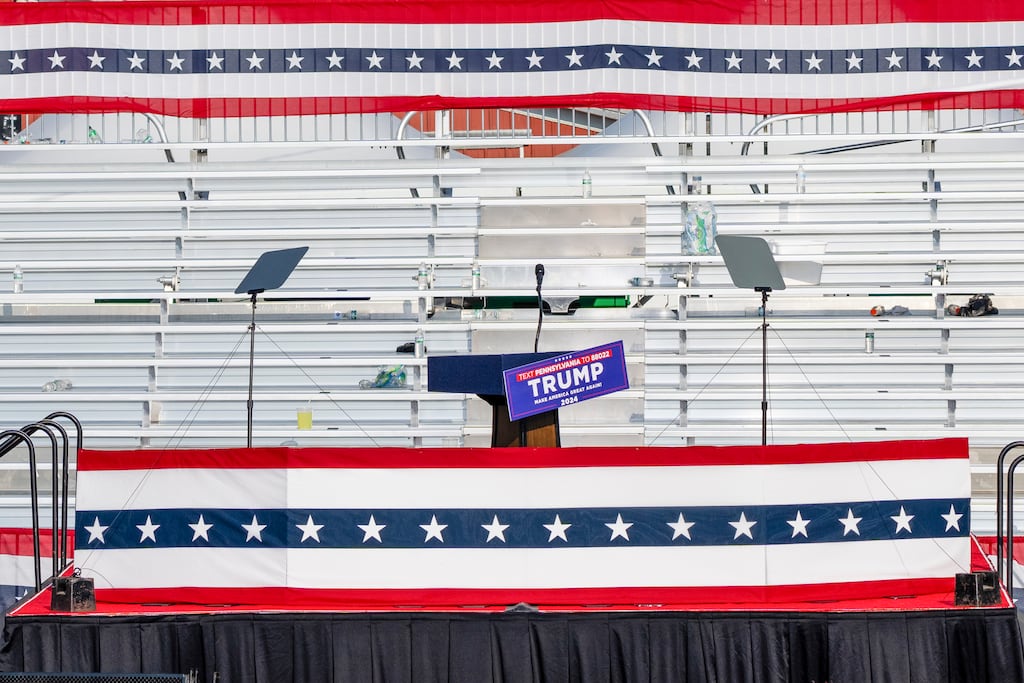The FBI is examining numerous metal fragments found near the stage at a campaign rally in Butler, Pennsylvania, to determine whether a would-be assassin’s bullet – or other potential sources of debris – grazed former president Donald Trump’s head, bloodying his right ear, according to the FBI and a federal law enforcement official.
The bureau has asked to interview Mr Trump as part of its broader investigation hoping to provide insights into the shooting and possibly a more complete record of his injury, the official said, speaking on the condition of anonymity to discuss the continuing inquiry.
Unanswered questions about the object that struck the Republican nominee for president have lingered since the July 13th shooting, with Mr Trump claiming that he was struck by a bullet – and casting his survival as an act of divine intervention that justifies his election.
FBI officials have been more circumspect, citing the need to analyse the evidence before determining what struck Mr Trump – a bullet, metal shard or something else.
READ MORE
The bureau’s shooting reconstruction team “continues to examine evidence from the scene, including bullet fragments, and the investigation remains ongoing”, the FBI said in a statement on Thursday. In addition to injuring Mr Trump, the gunman, Thomas Crooks (20), of Bethel Park, Pennsylvania, shot three rally attendees, one fatally.

Trump spokesperson Steven Cheung did not answer whether the bureau had asked to review the former president’s medical records after the incident, but Mr Trump has not released them publicly.
FBI officials view the identification of the projectile as important but not a central focus of a sprawling criminal investigation into the actions of the gunman. They are deeply interested in Crooks’s rationale or any indication that he might have had an accomplice or other help. So far they have not found a motive nor a conspirator.
“The bureau’s priority is finding whether anybody helped the shooter and eliminating any ongoing threat,” said Michael Harrigan, a former FBI special agent who ran the bureau firearms training unit in Quantico, Virginia. “From an investigative standpoint, knowing what happened to the president’s ear doesn’t really matter.”
It matters a great deal from a political standpoint.
“With respect to former president Trump, there’s some question about whether or not it’s a bullet or shrapnel that hit his ear,” FBI director Christopher Wray told Republican Jim Jordan, chair of the house judiciary committee, on Wednesday.
That statement prompted a fierce backlash and continuing ongoing Republican attacks on Mr Wray.
“It’s shocking Christopher Wray doesn’t know what the facts are, but that probably says more about his job performance – or lack thereof – than anything else,” Mr Cheung said.
Speaker Mike Johnson told NBC on Thursday: “We’ve all seen the video, we’ve seen the analysis, we’ve heard it from multiple sources in different angles that a bullet went through his ear. There’s a lot of frustration and concern about the leadership with these agencies.”
The FBI said in a statement that the bureau “has been consistent and clear that the shooting was an attempted assassination of former president Trump which resulted in his injury, as well as the death of a heroic father and the injuries of several other victims”.
It is not usual for the type of bullet that Crooks fired from his AR-15-style semi-automatic rifle to tumble end over end and break apart after hitting even a small solid object. Gun experts say a fragment might, for instance, have hit a metal stanchion.
Still, a bullet could have grazed Mr Trump’s ear, and the FBI has not ruled that out. Investigators found eight rifle casings on the roof where the shooter was positioned.
It is not clear if investigators have eliminated other potential sources of debris. But bureau analysts appear to be focused on metal fragments, as opposed to glass from the teleprompter onstage. Photos of the teleprompters next to Mr Trump show they were intact after the bullets were fired.
FBI analysts are also examining still images and other electronic evidence for clues.
Gun experts said the FBI could rely on trajectory analysis, a physical examination of any linked bullet and the president’s wound to possibly figure out what happened.
The bureau could also get lucky and find the former president’s DNA on a piece of a bullet. But even that would probably not establish if a fragment or the actual bullet hit his ear.
One other scenario investigators are likely to explore: that the bullet, deadly but friable, might have fragmented after skimming Mr Trump’s ear.
“The problem you have with a bullet travelling at 3,200ft per second is that it fragments very easily when it hits a surface before the target,” Mr Harrigan said. “It’s going to be tough with the fragmentation to definitely say what happened. ”
– This article originally appeared in The New York Times.















